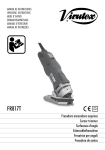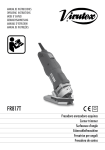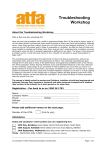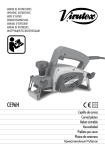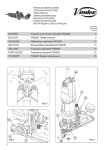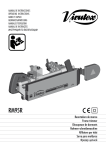Download AP98 - Virutex
Transcript
Modelo · Model · Modèle · Modell · Modello · Modelo AP98 5396049 MANUAL DE INSTRUCCIONES Español (p. 3) OPERATING INSTRUCTIONS English (p. 6) MODE D' EMPLOI Français (p. 8) GEBRAUCHSANWEISUNG Deutsch (s. 10) MANUALE D'ISTRUZIONI Italiano (p. 13) MANUAL DE INSTRUÇÕES Portugués (p. 15) Cepillo enrasador Edge lipping planer Rabot à araser Umleimerhobel Pialletto per bordi Plaina de cantos MANUAL DE INSTRUCCIONES OPERATING INSTRUCTIONS MODE D'EMPLOI GEBRAUCHSANWEISUNG MANUALE D'ISTRUZIONI MANUAL DE INSTRUÇÕES página/page seite/pagina страница ESPAÑOL Cepillo enrasador AP98 3 ENGLISH AP98 Edge lipping planer 6 FRANÇAIS Rabot à araser AP98 8 DEUTSCH Umleimerhobel AP98 10 ITALIANO Pialletto per bordi AP98 13 PORTUGUÉS Plaina de cantos AP98 15 Fig. 1 Fig. 2 2 Fig. 4 Fig. 3 Fig. 6 Fig. 5 Detalle W Ver detalle W Fig. 8 Fig. 7 3 5399059 SET OF 2 REV. BLADE BEARINGS 6446073 3.5 m EXTERNAL DUST COLLECTION HOSE 5. GENERAL DESCRIPTION AND APPLICATIONS The AP98 edge lipping planer comes equipped with: • Hard-metal reversible blades. • Knob for adjusting cutting depth, enabling a flushing height from 11 mm to 0. • Side guides, for flushing work that takes the edge of the piece as a reference. • Dust collector connection. • Upwardly-engaging safety button, which prevents the machine from being started up accidentally. The AP98 edge lipping planer is a tool that will prove useful to carpenters, fitters and restorers. It has been especially designed for the recessing and flushing of: woods, varnished woods, stratified woods, softwoods and synthetic materials. For maximum performance, the selfsame weight of the machine is the only pressure that should be applied; do not force it, which will reduce its speed and output. 6. STARTING AND STOPPING THE MACHINE This edge lipping planer is equipped with an upwardly-engaging safety button that prevents the machine from being started up accidentally. To start up the machine, press down on the safety button Z while simultaneously depressing the power button A1 (Fig. 1). Before plugging in the machine, ensure that the power supply voltage is compatible with that stated on its specifications plate, and that the blade-holder guard is properly attached. 7. CUTTING ADJUSTMENTS FLUSHING HEIGHT Unscrew knob A (Fig. 1) in the counter-clockwise direction until reaching the end of the thread. Spin the wheel B to raise or lower the cutter-block, adjusting it to the necessary flushing height. After setting the flushing height, screw on the knob A in the clockwise direction until it becomes firmly tightened in place. 8. SIDE GUIDE The side guide C (Fig. 1) enables flushing by following the edge of the board. It can be set using knob D and then tightened using the 6-mm Allen wrench E. 9. DUST COLLECTOR CONNECTION The machine is equipped with a dust collector connection F (Fig. 1) which can be used for connection to our AS182K, AS282K and AS382L dust collector or any industrial equivalent via the STANDARD DUST COLLECTOR ATTACHMENT (ref. 6446073). WARNING! The dust collector connection F (Fig. 1) must never be set up on the machine if no collector is used. This would prevent the free ejection of chips. 10. REPLACING AND CONTROLLING THE BLADES ATTENTION: Disconnect the equipment from the mains before carrying out this operation. 1. REPLACING BLADES AND BLADE HOLDERS To replace blades or reverse them in order to use the second cutting edge, follow the steps below: Loosen the two fastening screws G (Fig. 2) in the clockwise direction using the service key. Turn the cutter-block casing to a suitable position so that the blade H can be lined up with the groove I of the guard, so as to have enough space to move and laterally remove the blade from its housing in holder J. Remove any dust and resin from the seats of the cutter-block and supports before inserting new blades. Replace the old blade with a new one, or with the same blade reversed, using its second cutting edge. Reinsert the blade in the recess of the blade holder J (Fig. 3), ensuring that the blade H and its holder J do not protrude out from the side of the cutter-block P. Securely tighten the two screws G (Fig. 2) in the counter-clockwise direction using the service key. If it is necessary to replace the blade holders J of the cutter-block, loosen the 2 screws K (Fig. 4), unscrew the screw L and remove the cutter-block guard M, which will leave the blade bearings J in view. 2. ADJUSTING BLADES AND BLADE HOLDERS Blade holders are regulated before leaving the factory and do not require readjustment when changing the blade. Nonetheless, if for any reason they have to be adjusted, do so as follows: Using the knob A and the wheel B (Fig. 1 and 6), align and block the surface of the base N (Fig. 5) with the cutting edge of the blade in the best condition, which will used as a reference. In the event that blade holders or blades become 7 lost or worn out, leave a distance of 1 mm between the surface of base N and the diameter of the cutter-block P (Fig. 6). Loosen slightly in the clockwise direction the two screws G (Fig. 2) of the blade blade holder J, which should be adjusted using the service key. Place a rule over the base and adjust the screws R (Fig. 5) in order to withdraw or retract the blade holder with the fitted blade until the entire length of its cutting edge is flush and parallel with the base N. Check that the side of the blade H does not protrude out from its holder J, and that the blade holder is lined up with the side of the cutter-block P (Fig. 3), and tighten the two screws G (Fig. 2) in the counterclockwise direction with the service key. WARNING! Ensure that the 4 screws G (Fig. 2) are well-tightened before resuming work with the edge lipping planer after making any blade changes or blade holder adjustments. When replacing the cutter-block, use only original VIRUTEX components. 11. CHANGE OF THE DRIVING BELT ATTENTION: Disconnect the equipment from the mains before carrying out this operation. Remove the protective cover S (Fig. 7), unscrewing the screw T that fastens it. Unscrew and remove knob D (Fig. 1). Loosen the two screws U (Fig. 7), dislodge the motor unit X from its interior housing and remove the worn-out belt V from the driving pulley. Carefully clean the pulley and driving wheel before replacing the belt with a new genuine VIRUTEX belt. Mount the new toothed belt X, making sure that its teeth are properly intermeshed with those of the blade-holder pulley and those of the driving wheel. Once the belt has been fitted onto the pulleys, refit the motor unit V in its housing, carefully screwing down the two screws U (without forcing them), until it is properly seated, and put knob D back in place (Fig. 1). 12. MAINTENANCE OF BRUSHES AND COLLECTOR WARNING! Always remove the plug from the mains socket before carrying out any work on the machine. It is important that brushes be changed when they have a minimum length of 5 mm. Unscrew the lid Y (Fig. 8) and remove the brushes from the guides. Replace brushes with genuine VIRUTEX brushes and check to ensure that they slide smoothly in their guides. 8 After screwing the lid back on, it is recommended to leave the machine running for 15 minutes in order to ensure that brushes adapt properly. WARNING! Should you detect burns or ribbing on the collector, have it repaired at a VIRUTEX technical service outlet. 13. NOISE AND VIBRATION LEVEL The noise and vibration levels of this electrical device have been measured according to the European standard EN50144. The noise level in the workplace can exceed 85 dB(A), in which case it is necessary for the user to take noise protection measures. 14. WARRANTY All VIRUTEX power tools are guaranteed for 12 months from the date of purchase, excluding any damage which is a result of incorrect use or of natural wear and tear on the machine. All repairs should be carried out by the official VIRUTEX technical assistance service. VIRUTEX reserves the right to modify its products without prior notice. Français RABOT À ARASER AP98 1. INSTRUCTIONS DE SECURITE POUR L'UTILISATION DU RABOT ATTENTION! Lire attentivement la BROCHURE D'INSTRUCTIONS GÉNÉRALES DE SÉCURITÉ jointe à la documentation de la machine. 1. Avant de brancher la machine, vérifier si la tension d'alimentation correspond à celle indiquée sur la plaque des caractéristiques. 2. Porter des lunettes de sécurité pour travailler avec cette machine. 3. Prendre soin de ne pas mettre les mains sur la zone de coupe, et de toujours prendre la machine par la poignée. 4. Éviter de couper des clous. Vérifier la surface à travailler avant de rabotter. 5. Débrancher la machine du secteur avant de faire toute opération d'entretien. 6. Utiliser uniquement des couteaux d'origine VIRUTEX. Ne jamais utiliser de couteaux qui ne seraient pas aiguisés, ayant des mesures incorrectes, défectueux ou en mauvais état. 7. Toujours utiliser le porte-lames et les supports de lames d'origine VIRUTEX montés sur la machine. En cas de besoin, les remplacer par des pièces de rechange d'origine VIRUTEX. utiliser le tranchant disponible sur la seconde face de coupe, effectuer les opérations suivantes: Dévisser les deux vis de fixation G, (Fig. 2), en utilisant la clé de service, dans le sens des aiguilles d'une montre. Faire tourner le corps du porte-couteaux pour obtenir une position correcte permettant de mettre face à face le couteau H avec la rainure I du protecteur, afin d'avoir l'espace suffisant pour déplacer et extraire latéralement le couteau de son logement dans le support J. Il convient de nettoyer la poussière et la résine se trouvant dans les logements du porte-couteaux et les éléments de serrage avant de monter des couteaux neufs. Remplacer le couteau par un neuf ou inverser celui que l'on avait retiré pour utiliser le tranchant de sa seconde face de coupe. Introduire de nouveau le couteau dans la rainure du profil du support couteau J, (Fig. 3), en prenant soin d'éviter que le couteau H et son support J dépassent sur le côté du corps du porte-couteaux P. Serrer fermement les deux vis G, (Fig. 2), dans le sens contraire des aiguilles d'une montre avec la clé de service. Pour remplacer, en cas de besoin, les supports couteaux J, du corps porte-couteaux, il faut dévisser les 2 vis K, (Fig. 4), dévisser la vis L, retirer le protecteur porte-couteaux M pour dégager les supports couteaux J. 2. RÉGLAGE DES COUTEAUX ET DES SUPPORTS COUTEAUX Les éléments de serrage des couteaux sont réglés d'origine et n'ont pas à être réajustés quant on change les couteaux. Cependant si pour une raison quelconque il fallait les réajuster, faire comme suit: À l'aide du bouton A et du galet B, (Fig. 1 et 6), aligner et bloquer la surface du socle N, (Fig. 5), avec le tranchant du couteau, en meilleur état, que l'on prendra comme référence. En cas de perte ou de détérioration totale des supports couteaux ou des couteaux, laisser une distance de 1 mm entre la surface du socle N et le diamètre du corps du porte-couteaux P, (Fig. 6). Dévisser légèrement, dans le sens des aiguilles d'une montre, les deux vis G, (Fig. 2), du support couteau J, qu'il faut régler avec la clé de service. Mettre une règle sur le socle et régler les vis R, (Fig. 5), pour dégager ou cacher le support, avec le couteau monté, pour que toute la longueur du tranchant soit bien arasée et parallèle au socle N. Vérifier que le côté du couteau H ne dépasse pas de son support J et que le support couteau est bien aligné avec le côté du porte-couteaux P, 10 (Fig. 3), serrer les deux vis G, (Fig. 2), dans le sens contraire des aiguilles d'une montre avec la clé de service. ATTENTION! S'assurer que les 4 vis G, (Fig. 2) sont bien serrées avant de reprendre le travail avec le rabot à araser, après tout changement de couteaux ou réglage de leurs supports. Pour les pièces de rechange de la tête à couteau, utiliser exclusivement des composants d'origine VIRUTEX. 11. SUBSTITUTION DE LA COURROIE DE TRANSMISSION ATTENTION! Débrancher la machine du secteur avant de réaliser cette opération. Retirer le couvercle de protection S (Fig. 7), en dévissant la vis T qui le fixe. Dévisser et retirer le bouton D, (Fig. 1). Dévisser les deux vis U, (Fig. 7), déplacer le bloc moteur X dans son emboîtement intérieur et retirer de la poulie motrice, la courroie V détériorée. Nettoyer soigneusement la poulie et la roue motrice avant de remplacer la courroie par une autre, d'origine VIRUTEX. Monter la nouvelle courroie crantée V, en prenant soin de bien engrener ses dents avec celles de la poulie du porte-couteaux et celles de la poulie motrice. Quand la courroie est bien située sur les poulies, emboîter de nouveau le bloc moteur X, dans son logement, en vissant peu à peu et sans forcer les deux vis U, jusqu'à ce qu'il soit bien fixé, et installer de nouveau le bouton D, (Fig. 1). 12. ENTRETIEN DES BALAIS ET DU COLLECTEUR ATTENTION! Débrancher la machine du secteur avant de faire toute opération d'entretien. Il est recommandé de remplacer les balais quand ils atteignent 5 mm de longueur minimum . Dévisser le bouchon Y, (Fig. 8), et retirer le charbon du guidage. Remplacer les balais par d'autres, d'origine VIRUTEX et vérifier qu'ils glissent aisément dans leurs guidages. Visser de nouveau le bouchon de leur logement. Il est recommandé de laisser la machine en marche durant 15 minutes pour que les balais s'adaptent correctement. ATTENTION! Si on constate que le collecteur présente des brûlures ou des ressauts, il faut le faire réparer par un Service Technique VIRUTEX. 13. NIVEAU DE BRUIT ET DE VIBRATIONS Le niveau de bruit et de vibrations de cet outil électrique a été mesuré conformément à la Norme Européenne EN50144.






